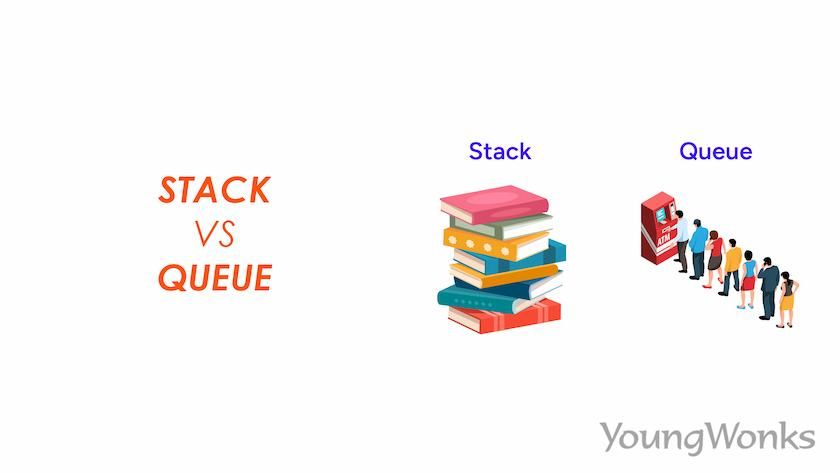Mar 04, 2024 By Team YoungWonks *
Stacks: Understanding the LIFO order
Imagine a stack of plates in a cafeteria. The first plate you add goes on top, and when you need a plate, you always take the one from the top. This "Last In First Out" (LIFO) principle is the essence of a stack data structure.
What operations can be performed on a stack?
The following operations can be performed on a stack:
Push Operation
This operation adds a new element to the top of the stack. It's like placing a new plate on top of the existing stack.
Example: Imagine you have a stack of plates, and you want to add a new plate (element) named "Dinner Plate." You would use the push operation to add this element to the top of the stack.
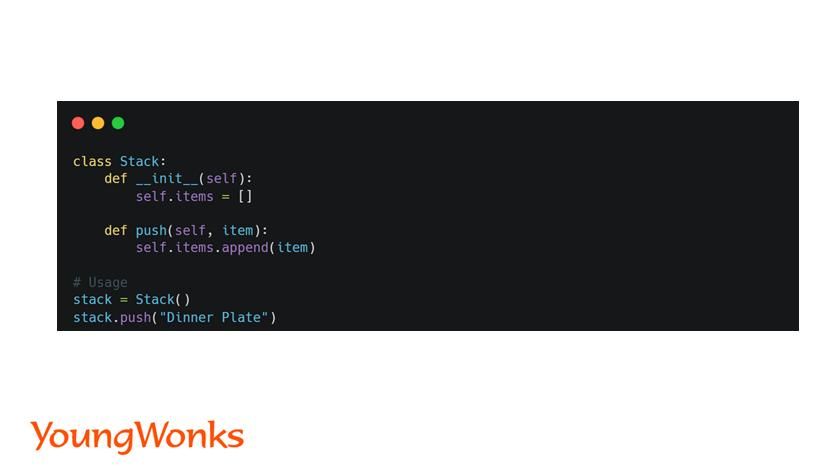
In this code snippet, a simple stack class is defined with an initialization method(__init__) that initializes an empty list(self.items). The push method is then defined to add an item to the stack, and it utilizes the append method of the list to add the item to the end of the stack.
Here, an instance of the Stack class is created, and the push method is used to add a "Dinner Plate" to the stack.
Pop Operation
This operation removes and returns the element from the top of the stack. It's like taking the top plate off the stack.
Example: Continuing with the plate analogy, if you want to use a plate, you would use the pop operation to remove the "Dinner Plate" from the top of the stack.
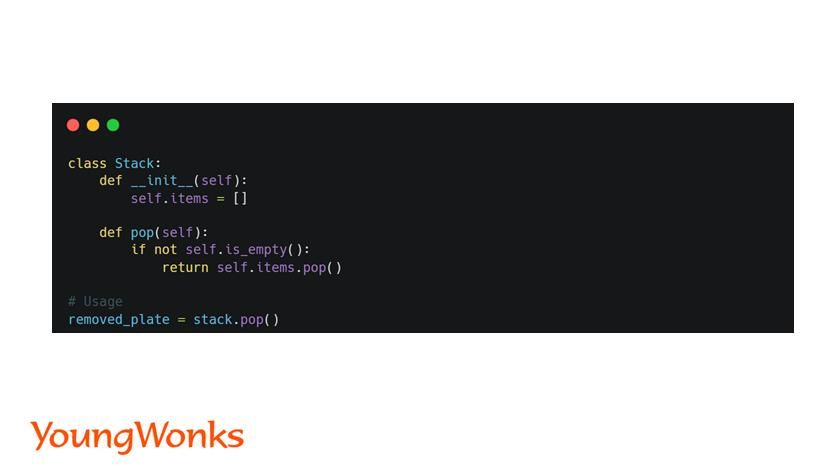
The pop method is defined to remove and return the last item added to the stack using the pop method of the list. The if not self.is_empty(): condition ensures that the stack is not empty before attempting to pop an element.
Here, the pop method is called on the stack, and the removed item is stored in the variable removed_plate.
Peek Operation
This operation retrieves the element at the top of the stack without removing it. It's like peeking at the top plate without taking it off.
Example: You might want to know what the top plate (element) is before using it. The peek operation allows you to see that it's the "Dinner Plate" without removing it from the stack.
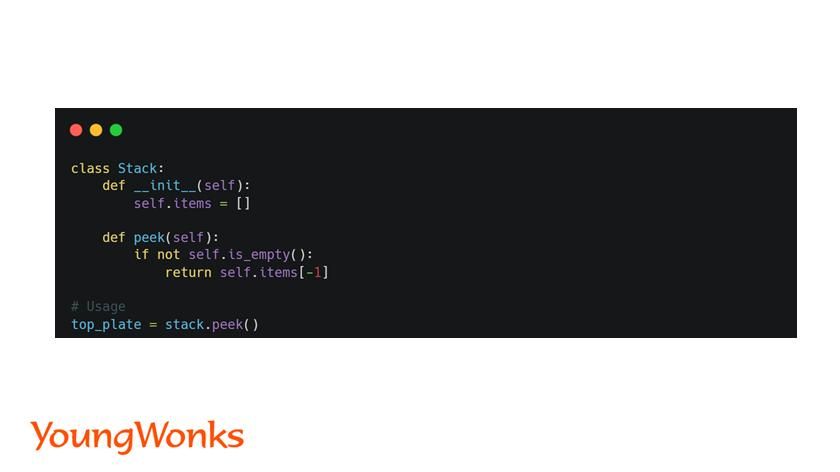
The peek method is defined to retrieve the last item added to the stack without removing it. It uses the index -1 to access the last element of the list.
Is Empty Operation
This operation checks if the stack is empty, meaning there are no elements present. It's like checking if there are any plates left in the stack.

The is_empty method is defined to check if the stack is empty by verifying if the length of the list is equal to 0.
These code snippets demonstrate the fundamental operations of a stack (push, pop, peek, and is_empty) implemented in Python using a simple class and list data structure.
How to implement a stack?
Stacks can be implemented using two main approaches:
Stacks using Arrays
Arrays offer fast access to elements, but their size is fixed, limiting flexibility.

This provides constant-time access to elements, making it efficient for stack operations. However, the main drawback is that the size of the array is fixed when it's created, limiting the flexibility to dynamically resize.
In this example, the StackUsingArray class is initialized with a fixed size, and push and pop operations are implemented accordingly. The stack keeps track of the top element using the variable top.
Stacks using Linked Lists
Linked lists provide dynamic resizing, allowing the stack to grow or shrink as needed, but random access is slower compared to arrays.

Linked lists allow dynamic resizing, providing flexibility for the stack to grow or shrink. However, random access to elements is slower compared to arrays.
In this example, the StackUsingLinkedList class utilizes a linked list to implement the stack. The Node class represents individual elements, and the top variable points to the top of the stack.
These implementations showcase the trade-offs between using arrays and linked lists for stack implementation. Arrays offer fast access but have a fixed size, while linked lists provide dynamic resizing at the cost of slower random access. The choice depends on the specific requirements of the application. The implementation of stacks as a linear data structure in software engineering involves careful consideration of the rear end and the efficient management of the topmost element.
What are the applications of stacks?
Stacks have various applications in computer science, including:
- Function Calls: Operating systems use stacks to keep track of function calls, ensuring proper execution and return.
- Expression Evaluation: Stacks are used to evaluate expressions in the correct order, especially for postfix expressions.
- Undo/Redo Functionality: Many software programs use stacks to implement undo/redo features, allowing users to revert actions.
- Backtracking Algorithms: Algorithms like depth-first search utilize stacks to explore different paths and backtrack if necessary.
- Breadth-First Search: Algorithms like breadth-first search utilize queues to explore nodes level by level in a graph, ensuring all nodes at a specific distance are visited before moving to the next level.
- Buffering: Queues are used to buffer data between producers and consumers, preventing overflow and ensuring smooth data flow. This is crucial in scenarios like network communication or file I/O operations.
- Real-time Applications: Queues play a vital role in real-time systems by handling incoming requests and messages in the order they arrive. This ensures timely processing and responsiveness in applications like chat systems or online games.
What is a Queue Data Structure?
Think of a queue at a bus stop. People arrive and join the line at the back, and they are served on a "First In First Out" (FIFO) basis. This principle forms the foundation of a queue data structure.
What operations can be performed on a queue?
The following operations can be performed on a queue:
Enqueue Operation
This operation adds a new element to the back of the queue. It's like joining the line at the end.
Example: Imagine a queue of people waiting for the bus. You would use the enqueue operation to add yourself (element) to the back of the line.

Dequeue Operation
This operation removes and returns the element at the front of the queue. It's like the person at the front of the line being served and leaving.
Example: The bus arrives, and the first person in line (the front element) would use the dequeue operation to be removed from the queue and board the bus.
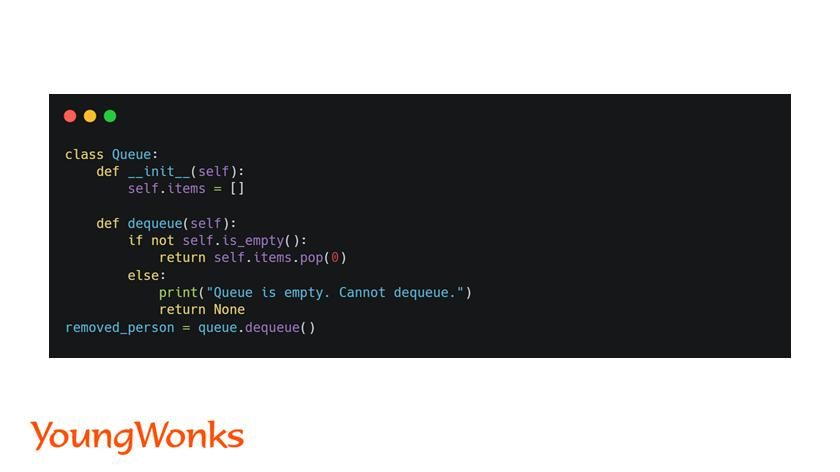
Peek Operation
This operation retrieves the element at the front of the queue without removing it. It's like checking who is next in line without them leaving.
Example: You might be curious who is next in line before the bus arrives. The peek operation allows you to see that it's the person in front of you without them leaving the queue.
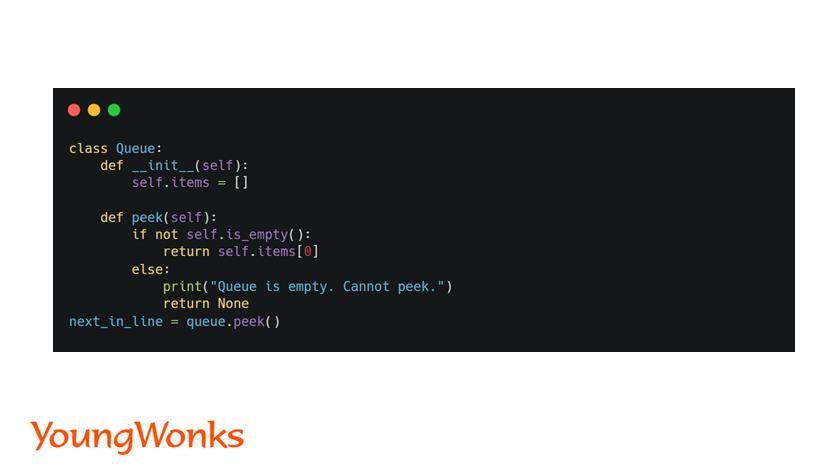
Is Empty Operation
This operation checks if the queue is empty, meaning there are no elements present. It's like checking if there's anyone waiting in line.
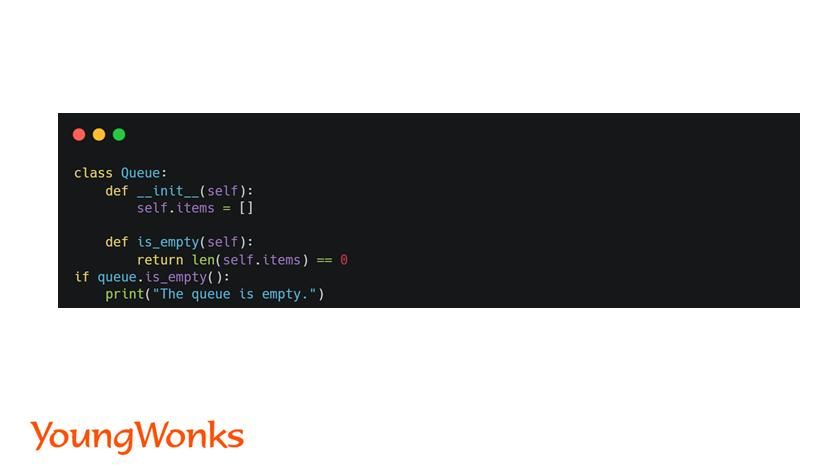
How to implement a queue?
Queues are typically implemented using linked lists. This approach allows for dynamic resizing and efficient insertion at the back, aligning well with the FIFO nature of queues.
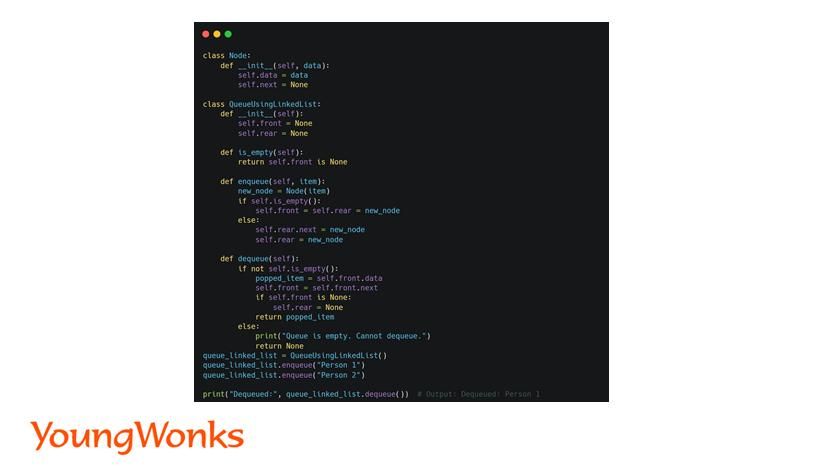
In this example, the QueueUsingLinkedList class is implemented using a linked list. The Node class represents individual elements, and the front and rear variables point to the front and rear of the queue, respectively.
These code snippets illustrate the fundamental operations of a queue (enqueue, dequeue, peek, and is_empty) and a queue implementation using linked lists in Python. Understanding these concepts is crucial for efficient data manipulation in various applications.
What are the applications of queues?
Queues have diverse applications in various systems, including:
- Task Scheduling: Operating systems use queues to schedule tasks, ensuring processes are handled in the order they arrive.
- Breadth-First Search: Algorithms like breadth-first search utilize queues to explore nodes level by level in a graph, ensuring all nodes at a specific distance are visited before moving to the next level.
- Buffering: Queues are used to buffer data between producers and consumers, preventing overflow and ensuring smooth data flow. This is crucial in scenarios like network communication or file I/O operations.
- Real-time Applications: Queues play a vital role in real-time systems by handling incoming requests and messages in the order they arrive. This ensures timely processing and responsiveness in applications like chat systems or online games.
What is the difference between a queue and a stack?
When comparing two fundamental data structures, the stack and the queue, key differences emerge, primarily rooted in their distinct ordering principles and operational behaviors.
Ordering Principle
The fundamental distinction between a stack and a queue lies in their ordering principles. A stack adheres to the Last In, First Out (LIFO) principle, meaning that the last element added is the first one to be removed. On the other hand, a queue follows the First In, First Out (FIFO) principle, where the first element added is the first to be removed.
Insertion and Deletion
In a stack, insertion (push operation) is performed at the top, adding a new element to the top of the stack, and deletion (pop operation) is also carried out at the top, removing the most recently added element. In contrast, a queue involves insertion (enqueue operation) at the back, appending a new element to the end of the queue, and deletion (dequeue operation) at the front, removing the element that has been in the queue the longest.
Access
Both stacks and queues lack random access capabilities. Unlike arrays where direct access to any element is possible, accessing elements in a stack or a queue is restricted to the top or front, respectively.
Implementation
To implement stack you can use either arrays or linked lists, queues are typically implemented using linked lists. The choice of implementation depends on the specific requirements of the application, with arrays offering fast access but having a fixed size, and linked lists providing dynamic resizing capabilities.
Applications
The diverse applications of stacks encompass function calls, expression evaluation, undo/redo functionality, and backtracking algorithms. Stacks are instrumental in managing the execution flow in operating systems and parsing expressions during software development.
In contrast, queues find their utility in task scheduling, breadth-first search (BFS) algorithms, buffering to prevent overflow in scenarios like network communication, and real-time systems where incoming requests are processed in the order of their arrival. Queues ensure orderly execution in applications such as chat systems or online games
Choosing the Right Tool: Stack vs Queue
Selecting between a stack and a queue depends on the specific requirements of your program. Here are key factors to consider:
- Ordering Requirement: Do elements need to be processed in the order they were added (FIFO) or the reverse order (LIFO)?
- Access Needs: Do you require random access to elements, or is only access to the front or top element necessary?
- Memory Constraints: If memory efficiency is a concern, consider the implementation details of each data structure.
Role of Stacks and Queues in Technology and Web Development
In the realm of Data Structures and Algorithms (DSA), Java's priority queues and JavaScript's handling of data types — especially in front-end web development — illustrate the critical application of stacks and queues in software development. Java, with its priority queue, and JavaScript, essential for front-end tasks, utilize these structures for efficient data management. Circular queues are particularly significant in scenarios requiring a circular arrangement, optimizing the use of front and rear pointers for effective traversal.
The concept of recursion impacts the implementation of binary search within a binary tree, showcasing the adaptability of stacks in problem-solving. Similarly, the use of doubly linked lists offers a flexible approach to data handling, allowing bidirectional traversal and accommodating both front and rear pointers. Time complexity, an essential consideration, influences the CPU's processing efficiency, directly affecting algorithm performance.
Real-life applications, such as parentheses matching, underline the practical significance of these structures, demonstrating the stack's capacity for ensuring correct nesting. In dynamic tech landscapes, including those in the United States and India, proficiency in these data structures — considering aspects like front pointer manipulation and the integration of HTML for dynamic web interfaces — remains invaluable for developers and DSA enthusiasts. This condensed exploration underscores the foundational role of stacks and queues, driven by considerations of priority, circular processing, traversal, and time complexity, in the technological and problem-solving domains.
Empowering Young Minds with Essential Coding Skills at YoungWonks
At YoungWonks, we believe that understanding the fundamental concepts of computer science, such as the difference between stacks and queues, is crucial for young learners embarking on their coding journey. Our comprehensive Coding Classes for Kids are tailored to provide students with a strong foundation in these concepts, enabling them to tackle complex programming challenges with ease. For those interested in deepening their programming skills, our Python Coding Classes for Kids offer an in-depth look into one of the most popular and versatile programming languages today. Additionally, for young enthusiasts fascinated by hardware programming and game development, our combined course on Raspberry Pi, Arduino, and Game Development Coding Classes opens up a world of possibilities, from creating their own gadgets to developing interactive games.
*Contributors: Written by Riya Kumari Singh; Edited by Rohit Budania; Lead image by Shivendra Singh
